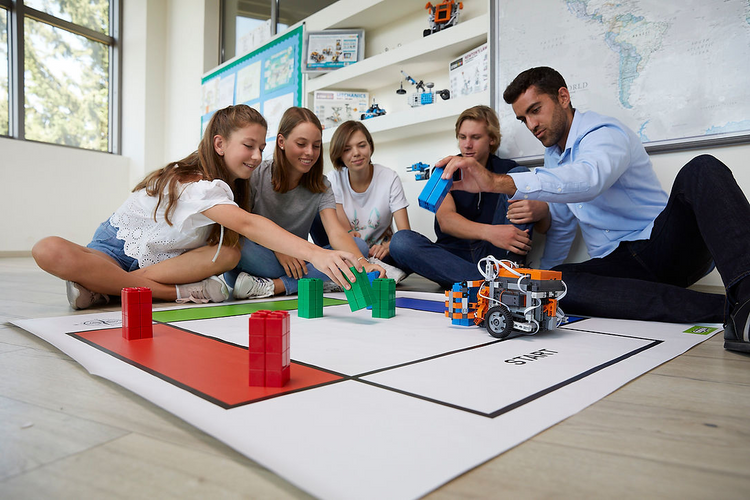
Building System Classic
Big Discoveries for Little Hands!
Classic Building System
The ENGINO® classic building system is perhaps the most advanced and versatile three dimensional construction toy system in the market today.The patented design of the parts allows connectivity of up to 6 sides simultaneously, while the unique extendable components lead to buildsthat were previously unthinkable, unleashing children’s creativity and imagination. The progressive building capability from simple to advanced isa consistent characteristic of all ENGINO® solutions, from tangible plastic parts to lesson plans and software, and it is at the core DNA of ourpedagogical philosophy.

Building in one direction
The ENGINO® rods can be connected in-line without the need of an intermediate connector, almost reducing to half the quantity of parts required to build models as compared to other systems. This is because the connecting plug’s geometry is already embedded within each rod. The biggest advantage in requiring half the number of parts, besides simplicity, is the fact that students will need half the time to build their model, saving time to be allocated for being more creative by trying their own ideas.

Building in two directions
The same rods which can be assembled horizontally in-line can also be connected vertically sideways! The unique plug geometry can click on any of the bi-directional side-holes of the rods, meaning that students can build without needing a new component- in two directions! Even though this is a big advantage by itself, the biggest innovation is that the rods can snap-fit on both sides of the rods simultaneously, something that greatly enhances the expandability of the system and reduces even more the number of parts needed to construct a model.

Building in three directions
The Classic ENGINO® system consists of “rods” and “connectors”. In essence, these “connectors” share the same geometrical designs as the rods, establishing a multiplier effect that enables a further reduction in the number of parts needed to construct a model. In most cases this means 4 times less parts are required to build a model as compared to other building systems. In effect, this means that students can not only create a model 4 times faster, but they can spent 4 times less effort to modify and experiment!

Building in fixed angles
Modelling real-life machines and buildings requires also connecting components at an angle other than 90 degrees. The system includes 45-degree angular parts, which with the same ease can snap-fit on the rods and connectors to create more complex models.

Triangulating
To make a frame stronger a technique called Triangulation is used, something which is clearly visible in many large bridges and wooden structures. With ENGINO®, triangulation is very easy to achieve, ideally with side-lengths of 15 units. Converting a structure from a flat two-dimensional shape to a three-dimensional one, for example adding pillars on floors when making a model of a house, is straight forward with ENGINO®. Simply snap a rod directly on the ELBOW or TEE connectors! These provide a change in the plane of building, without having any elements protruding, allowing also easy modification at any time without having to substitute these connectors with different ones.

Connecting in every angle
The potential of the system is unleashed by “cloning” the innovative geometries to pivoted joints. A specially designed component acts as a pivot (called internally “swing rod”) and allows any angle of the 3D space to be created, not restricted by 45 or 90 degrees!

Connecting everywhere
ENGINO® solved the age-old building challenge of fixed rod lengths with its innovative extendable rods. Two interlocking pieces twist to create any length, enabling perfect triangulation and limitless designs. Combined with pivot joints, they unlock construction possibilities never before achievable all with fewer parts and more creativity.

Connecting DIY surfaces
The assembled components of ENGINO® can have a flush surface with no protrusions. This has been designed on purpose for a very unique and specific reason: To allow children to cover their models with flat surface panels without obstructions. These panels can be from paper, acrylic or wooden materials, which kids can draw, paint and cut to their own ideas, making the models more realistic. This feature is the first step into the maker-space era providing a bridge between construction toys and real DIY projects. Surfaces can attach very easily on ENGINO® models by using the latest designed lock-pins, which secure the panels on the Engino rods with a simple click!

Driving the Maker-space revolution
ENGINO® created plastic modular wood connectors to solve the challenge of building with wooden dowels in Design & Technology classrooms. Today, they perfectly support the Maker-space movement, offering easy-to-use DIY building materials compatible with all ENGINO® parts. This allows students and hobbyists to combine plastic components with wooden beams cut to any size, enabling creative hybrid models. The connectors also work with DIY surfaces and lock-pins, encouraging open-ended projects for learners of all ages.






